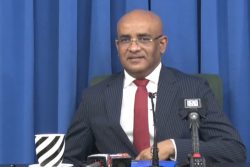Two men, whose skeletal remains were discovered at 72 Miles, Issano, in late February, died from gunshot wounds.
Head of the Criminal Investiga-tion Department, Assistant Commis-sioner Seelall Persaud told Stabroek News yesterday that post-mortem examinations were conducted on the remains last week by Government Pathologist Dr Nehaul Singh. The pathologist, Persaud said, reported that the men died from gunshot wounds.
Persaud further stated that police have not been able to identify the dead persons. Initially, it was suspected that the remains were those of two miners who had visited the area but were not heard from again. When the dead men are identified, Persaud said, the next step will be to send samples overseas for testing.
On February 27, police had said in a statement that they were investigating a report received the previous day that two decomposed bodies were found along a trail at 72 Miles, Issano. The area marks the point which is 72 miles away from the settlement of Issano. Bartica is the closest community to the location.
A team of investigators subsequently visited the Region Seven location and discovered the skeletal remains of the two men. The bones were brought to the city and stored at the Lyken’s Funeral Parlour.
A senior police source later pointed out that it will be extremely difficult for police to get anywhere with the investigation until they identify the dead men. The identification process, the source said, will be a challenge since there are no consistent records of who enters any mining district and whether or not they depart the location.
Now that it has been established that the men were murdered, the source stressed, there is more pressure on police to identify them.
In an invited comment, Regional Democratic Council (RDC) Chairman of Region Seven Holbert Knights noted that it is “easy to conceal such crimes” in the mining district. He was very sympathetic to police and stressed that security is generally an issue in the mining districts because of the difficulty of accessing the areas and poor communication network in such areas.
Knights explained that it is mandatory for persons using Bartica as their gateway to the mining district to stop at the community’s police station to log their names and addresses. However, Knights said the individuals are not required to provide police with any form of identification and many do not even bother to stop in at the station.
“No one wants to travel to such areas with important document with their ID cards… and while the check may be mandatory not everyone will check in with the police and it very difficult for police to enforce this particular rule. You can’t expect the police to go chasing after unknown miners because they didn’t register themselves before going into the mining districts,” Knights explained.
The Regional Chairman further said that even when individuals stop to log their names and addresses with police it is only a record that they entered the mining district. When miners exit the mining areas there is no record that they have done so. It is impossible, Knights said, to tell just who is in these areas.
Together the mining districts are far more expansive than the coast, Knights noted, and the fact that they are sparsely populated makes it harder for police to control the crime situation. Knights believes that the increase in price for gold has been responsible for the crime in the mining districts.
Trails – like the one at 72 Miles where the bones were discovered – are not frequently traversed by police because they do not have the manpower or the resources to do so in such rough terrain. However, Knights stressed that the Bartica Police Station is now more equipped than it was a year or two ago.
“They now have a fleet of three or so working vehicles and faster boat to traverse the waterway,” Knights said.
The police, he said, are doing the best they can with the resources available to them. It will take a lot of time and even more funds to improve the capacity of the Guyana Police Force to fight crime in interior locations, he said.









